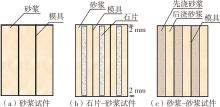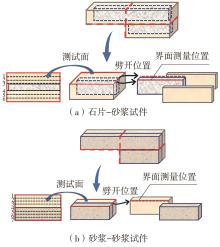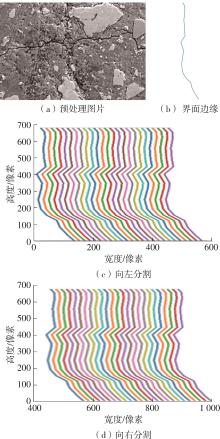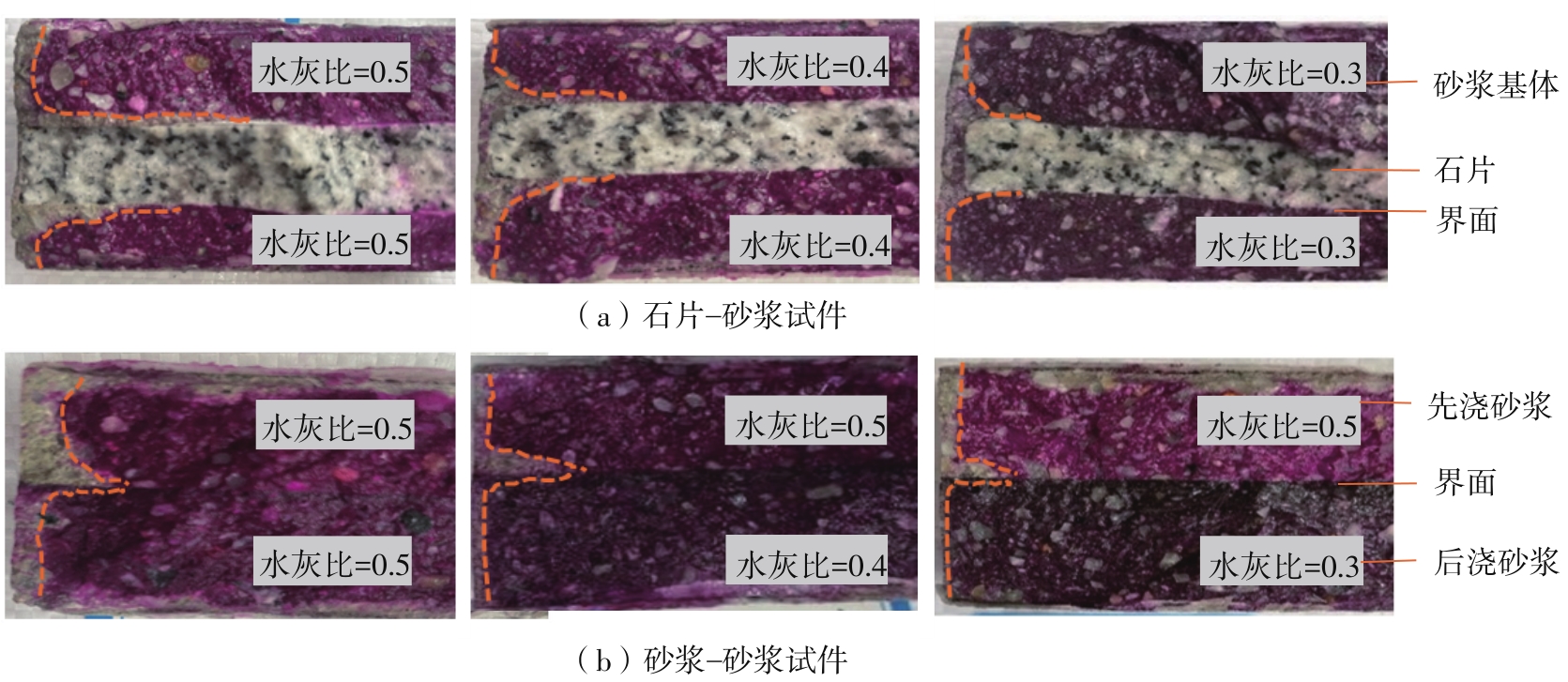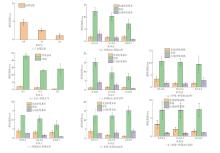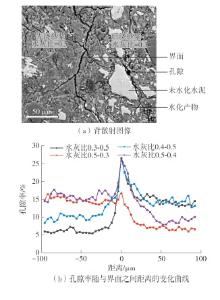Journal of South China University of Technology(Natural Science Edition) ›› 2023, Vol. 51 ›› Issue (7): 52-60.doi: 10.12141/j.issn.1000-565X.220637
Special Issue: 2023年土木建筑工程
• Architecture & Civil Engineering • Previous Articles Next Articles
Carbonation Properties and Pore Characteristics of Different Interfaces in Recycled Lump/Aggregate Concrete
WU Bo HUANG Tingting
- State Key Laboratory of Subtropical Building Science,South China University of Technology,Guangzhou 510640,Guangdong,China
-
Received:2022-09-30Online:2023-07-25Published:2022-11-11 -
Contact:吴波(1968-),男,博士,研究员,主要从事建筑固废再生利用与结构抗灾研究。 E-mail:bowu@scut.edu.cn -
About author:吴波(1968-),男,博士,研究员,主要从事建筑固废再生利用与结构抗灾研究。 -
Supported by:Key-Area Research and Development Program of Guangdong Province(2019B111107003);the National Natural Science Foundation of China(52078219)
CLC Number:
Cite this article
WU Bo, HUANG Tingting. Carbonation Properties and Pore Characteristics of Different Interfaces in Recycled Lump/Aggregate Concrete[J]. Journal of South China University of Technology(Natural Science Edition), 2023, 51(7): 52-60.
share this article
| 1 | EVANGELISTA L, DE BRITO J .Concrete with fine recycled aggregates:a review[J].European Journal of Environmental and Civil Engineering,2014,18(2):129-172. |
| 2 | KISKU N, JOSHI H, ANSARI M,et al .A critical review and assessment for usage of recycled aggregate as sustainable construction material[J].Construction and Building Materials,2017,131(30):721-740. |
| 3 | CORINALDESI V .Mechanical and elastic behaviour of concretes made of recycled-concrete coarse aggregates[J].Construction and Building Materials,2010,24(9):1616-1620. |
| 4 | WANG Z, WANG L, CUI Z,et al .Effect of recycled coarse aggregate on concrete compressive strength[J].Transactions of Tianjin University,2011,17(3):229-234. |
| 5 | KOU S, ZHAN B, POON C .Feasibility study of using recycled fresh concrete waste as coarse aggregates in concrete[J].Construction and Building Materials,2012,28(1):549-556. |
| 6 | ANDREU G, MIREN E .Experimental analysis of properties of high performance recycled aggregate concrete[J].Construction and Building Materials,2014,52(15):227-235. |
| 7 | KOU S, POON C .Effect of the quality of parent concrete on the properties of high performance recycled aggregate concrete[J].Construction and Building Materials,2015,77(15):501-508. |
| 8 | PEDRO D, DE BRITO J, EVANGELISTA L .Structural concrete with simultaneous incorporation of fine and coarse recycled concrete aggregates:mechanical,durability and long-term properties[J].Construction and Building Materials,2017,154(15):294-309. |
| 9 | LONG L, POON C, XIAO J,et al .Effect of carbonated recycled coarse aggregate on the dynamic compressive behavior of recycled aggregate concrete[J].Construction and Building Materials,2017,151(1):52-62. |
| 10 | 邸芃,付翠萍 .废弃混凝土破碎工艺及再生骨料的利用研究[C]∥2014中国环境科学学会学术年会论文集.成都:中国环境科学学会,2014:5639-5643. |
| 11 | 吴波,刘琼祥,刘伟,等 .钢管再生混合构件初探[J].工程抗震与加固改造,2008,30(4):120-124. |
| WU Bo, LIU Qiong-xiang, LIU Wei,et al .Preliminary study on steel recycled mixed members[J].Earthquake Resistance and Reinforcement of Engineering,2008,30(4):120-124. | |
| 12 | 严华 .再生混合混凝土及薄壁圆钢管再生混合短柱的轴压徐变性能试验研究[D].广州:华南理工大学,2014. |
| 13 | 余勇 .再生块体混凝土常温及高温后力学性能研究 [D].广州:华南理工大学,2019. |
| 14 | 金和卯 .再生块体混凝土的疲劳性能研究[D].广州:华南理工大学,2020. |
| 15 | WU B, LI Z .Mechanical properties of compound concrete containing demolished concrete lumps after freeze-thaw cycles[J].Construction and Building Materials,2017,155(30):187-199. |
| 16 | WU B, YAN J .Influences of size and shape of demolished concrete lumps on compressive behavior of compound concrete[J].Construction and Building Materials,2021,269(1):121317. |
| 17 | JIAN S, WU B .Compressive behavior of compound concrete containing demolished concrete lumps and recycled aggregate concrete[J].Construction and Building Materials,2021,272(22):121624. |
| 18 | LIN L, WU B .Water permeability behavior of recycled lump/aggregate concrete[J].Construction and Building Materials,2022,323(14):126508. |
| 19 | SILVA R V, NEVES R, DE BRITO J .Carbonation behaviour of recycled aggregate concrete[J].Cement & Concrete Composites,2015,62:22-32. |
| 20 | 申健,牛荻涛,王艳,等 .再生混凝土耐久性能研究进展[J].材料导报,2016,30(3):89-94,100. |
| SHEN Jian, NIU Ditao, WANG Yan,et al .Research progress on durability of recycled concrete[J].Materials Reports,2016,30(3):89-94,100. | |
| 21 | 王吉云 .再生骨料碳化处理对再生混凝土渗透性和界面的影响[D].长沙:湖南大学,2017. |
| 22 | PAPADAKIS V G, VAYENAS C G, FARDIS M N .Experimental investigation and mathematical modeling of the concrete carbonation problem[J].Chemical Engineering Science,1991,46(5/6):1333-1338. |
| 23 | 牛海成,范玉辉,张向冈,等 .再生混凝土抗碳化性能试验研究[J].硅酸盐通报,2018,37(1):59-66. |
| NIU Hai-cheng, FAN Yu-hui, ZHANG Xiang-gang,et al .Experimental study on carbonation behaviour of recycled concrete[J].Bulletin of the Chinese Ceramic Society,2018,37(1):59-66. | |
| 24 | 沈奇真 .碳化与荷载耦合作用下水泥基材料微结构演变与预测模型[D].南京:东南大学,2018. |
| 25 | MI R, PAN G, SHEN Q .Carbonation modelling for cement-based materials considering influences of aggregate and interfacial transition zone[J].Construction and Building Materials,2019,229(30):116925. |
| 26 | GARBOCZI E J, BENTZ D P .Multiscale analytical/numerical theory of the diffusivity of concrete[J].Advanced Cement Based Materials,1998,8(2):77-88. |
| 27 | 普通混凝土长期性能和耐久性能试验方法标准: [S]. |
| 28 | 建筑砂浆基本性能试验方法标准: [S]. |
| 29 | STUTZMAN P E, CLIFTON J R .Specimen preparation for scanning electron microscopy[C]∥Proceedings of the Twenty-First International Conference on Cement Microscopy.Nevada:National Institute of Standards and Technology,1999:10-22. |
| 30 | KJELLSEN K O, MONSY A, ISACHSEN K,et al .Preparation of flat-polished specimens for SEM-backscattered electron imaging and X-ray microanalysis-importance of epoxy impregnation[J].Cement and Concrete Research,2003,33(4):611-616. |
| 31 | WONG H S, HEAD M K, BUENFELD N R .Pore segmentation of cement-based materials from backscattered electron images[J].Cement and Concrete Research,2006,36(6):1083-1090. |
| 32 | JIANG Z, HUANG Q, XI Y,et al .Experimental study of diffusivity of the interfacial transition zone between cement paste and aggregate[J].Journal of Materials in Civil Engineering,2016,28(10):04016109/1-8. |
| 33 | WU K, SHI H, XU L,et al .Microstructural characterization of ITZ in blended cement concretes and its relation to transport properties[J].Cement and Concrete Research,2016,79:243-256. |
| 34 | DIAMOND S, HUANG J .The ITZ in concrete-a different view based on image analysis and SEM observations[J].Cement and Concrete Composites,2001,23(2/3):179-188. |
| [1] | LU Hongyao, XU Yude. Evolution of Interface Performance of Longitudinal Ballastless Track Under Temperature Load After Embedded Steel Bars [J]. Journal of South China University of Technology(Natural Science Edition), 2023, 51(8): 21-31. |
| [2] | DENG Kailing, WANG Duanyi, FANG Qiuping. Fracture Energy Test Method and Influencing Factors of Asphalt-Aggregate Interface [J]. Journal of South China University of Technology(Natural Science Edition), 2023, 51(8): 12-20. |
| [3] | WU Bo, CHEN Zhaonan, WANG Hui. Creep Behavior of Reinforced and Unreinforced Recycled Lump/Aggregate Concrete [J]. Journal of South China University of Technology(Natural Science Edition), 2022, 50(7): 35-42. |
| [4] | YIN Yushi FAN Yingfang GUO Xinyan. Effects of Roughness on Interfacial Bonding Properties Between Concrete and FRP [J]. Journal of South China University of Technology (Natural Science Edition), 2019, 47(5): 130-138. |
| [5] | TANG Zhengqiang ZHOU Dongdong JIA Tong ZHANG Chuanwei . Analysis of the Mechanical Properties of Head /Disk Interface in Air-Helium Gas Mixtures [J]. Journal of South China University of Technology (Natural Science Edition), 2019, 47(3): 44-52. |
| [6] |
CHENG Hao WANG Xuan ZHANG Jiasheng WANG Qiyun.
Effects of Roughness on Cyclic Shear Behavior of Red Clay-Concrete Interface
|
| [7] | LI Jing CHEN Xuyang LEI Rubai ZHANG Ding FAN Chunlei. Research on Thermal Performance Of Bi-In-Sn-Sb Quaternary Alloy Interface Materials [J]. Journal of South China University of Technology (Natural Science Edition), 2018, 46(11): 39-46. |
| [8] | ZHAN Jia-ming YAO Xiao-hu LI Wang-hui. A Probe into Mechanical Properties of Graphene/ SiC Composites Based on Molecular Dynamics [J]. Journal of South China University of Technology (Natural Science Edition), 2017, 45(5): 135-140. |
| [9] | CAI Min-xi YAO Ruo-he. Effects of Active Layer Thickness of Dual-Gate Amorphous InGaZnO Thin Film Transistors on Their Electrical Characteristics [J]. Journal of South China University of Technology (Natural Science Edition), 2016, 44(9): 61-66,72. |
| [10] | XIAO Min-min. Mixture Composition Design and Interface Properties of Asphalt Plug Expansion Joint [J]. Journal of South China University of Technology (Natural Science Edition), 2016, 44(8): 106-113. |
| [11] | DAI Gong-lian SU Miao . Numerical Stimulation of Interface Delamination Failure for Prefabricated Slab Ballastless Track [J]. Journal of South China University of Technology (Natural Science Edition), 2016, 44(7): 102-107,122. |
| [12] | HONG Lei DUO Run-min WANG Su-yan. Influence of Bond Length on Bonded Interface Performance of CFRP-C60 Concrete [J]. Journal of South China University of Technology (Natural Science Edition), 2016, 44(2): 14-19. |
| [13] | LONG Yao ZHANG Jia-sheng CHEN Jun-hua. Shear Characteristics of Structure Interface and Its Strain-Softening and Hardening Damage Model [J]. Journal of South China University of Technology (Natural Science Edition), 2016, 44(12): 128-134. |
| [14] | LI Jing CHEN Hao YIN Yao-bao. Oil Characteristic Analysis of Piston-Cylinder Interface in Axial Piston Pump with Radial Micro-Motion [J]. Journal of South China University of Technology (Natural Science Edition), 2016, 44(10): 30-35,42. |
| [15] | Wu Guo- guang Liu Gui- xiong Zhou Song- bin. Modeling and Dynamic Performance Evaluation of WTIM Based on Petri Nets [J]. Journal of South China University of Technology (Natural Science Edition), 2013, 41(9): 107-112. |
| Viewed | ||||||
|
Full text |
|
|||||
|
Abstract |
|
|||||


